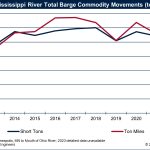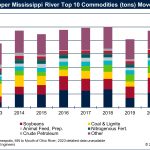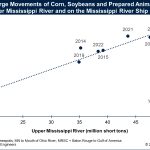
The Upper Mississippi River (UMR) extends 854 navigable river miles through the heart of the Corn Belt from Minneapolis past St. Louis to the mouth of the Ohio River at Cairo, Ill. It is the backbone of U.S. agricultural exports through the Mississippi River Ship Channel.
Commodities Sensitive To Weather And Policy
While the U.S. Army Corps of Engineers has posted commodity movement data through 2023 in its annual Fact Card and certain data sets, the Corps is yet to post detailed data in machine readable format. Despite not having 2023 data, the importance of the Upper Miss can still be appreciated.
From 2012 to 2022, UMR barge movements averaged 110 million short tons annually, ranging from 95.5 million in 2013 to 120.3 million in 2018 and 99.5 million in 2022.
The volumes moved from one year to the next vary widely. There was a large annual increase of 19 million shorts tons, or 20 percent, from 2013 to 2014. The drought of 2012 negatively impacted corn production and led to a historically low export program that influenced barge movements in 2013. The rebound in 2014 was high as a result.
Conversely, there was a large drop of 18.5 million short tons, or 15 percent from 2018 to 2019, related to the U.S. and China trade war that negatively impacted grain and soybean exports.
Commodity ton-miles (the number of short tons of cargo moved one mile) on the Upper Miss averaged 28.8 billion from 2012 through 2022, with a low of 22.6 billion in 2013 and a high of 33.6 billion in 2017. During 2022, commodity ton-miles totaled 25.3 billion.
Ton-mile changes from one year to the next are more extreme than the tons moved. From 2013 to 2014, for example, ton-miles increased 20 percent while falling 25 percent from 2018 to 2019.
Annual commodity movements on the Upper Mississippi River are shown in Figure 1.
Key Commodities
During any given year, there are more than 80 different commodity groupings at the four-digit code level moved by barge on the Upper Mississippi River. Since 2012, there have been 107 commodity groupings moved by barge on the UMR. This is an impressive list and reflects the economic opportunity and value that the Upper Mississippi offers.
However, despite the diverse number of commodities moved by barge, the top 10 commodities represented more than 70 percent of the total volume since 2012. Three of the top 10 commodity groupings were agricultural commodities, corn, soybeans and prepared animal feed. These three represented more than 36 percent of the volume. As an important fertilizer used on crops, nitrogen movements represented nearly 3 percent of total UMR volumes and would push the agricultural share close to three-quarters of the volumes on the UMR.
Coal movements historically have been large and important volumes, but volumes have slumped from a high of 23.9 million short tons in 2012 to a low of 6.6 million in 2021, a loss of nearly 17 million tons or a 72 percent drop. Coal has fallen due to the closure of coal-fired power plants or plants being converted to natural gas.
The top 10 commodities moved by barge on the Upper Mississippi are shown in Figure 2.
UMR Importance To Agriculture Exports
In many respects, so goes the movement of corn, soybeans and prepared animal feed on the UMR, so goes exports through elevators and facilities on the Mississippi River Ship Channel (MRSC) south of Baton Rouge, La. U.S. crop exports through the MRSC represent about 50 to 60 percent of U.S. exports from one year to the next.
The UMR sources about 63 percent of the grain, soybeans and prepared animal feed exported through the MRSC. The importance of the Upper Mississippi River cannot be overstated.
Monitoring crop plantings, growing conditions and progress across the vast fields of the Corn Belt, especially those areas on either side of the UMR, is important to understand. Adverse weather conditions impact crop potential and influence covered barge volumes.
Understanding the potential for U.S. corn, soybean and prepared animal feed exports’ outlook is also important, especially on what it means for exports through the MRSC.
Keeping an eye on UMR crop conditions and potential and the export outlook through the MRSC helps derive the need for barge service moving crops to export positions.
The strong relationship of corn, soybean and prepared animal feed barge movements on the UMR and on the Mississippi River Ship Channel is shown in Figure 3.
UMR’s Critical Role In U.S. Crop Exports
The connection between the Corn Belt and the UMR with the crop exports through the MRSC is important. U.S. crop exports plummeted to about 120 million metric tons during the 2022-23 crop marketing year from September to August, the lowest level since the 2012-13 drought-induced year.
Since then, crop exports have improved to 129.8 million metric tons in 2023-24. For 2024 to 2025, U.S. crop exports are forecast to be 141.8 million metric tons, while the forthcoming 2025 to 2026 crop marketing year is forecast to exceed 145.6 million, increasing for the third consecutive year and the fifth highest in U.S. history.
With U.S. crop exports forecast to hit 145.6 million metric tons in 2025-26, the Upper Mississippi’s role is vital. Barge operators and shippers must advocate for lock upgrades and adequate navigation channels and monitor crop conditions to sustain this global lifeline.







